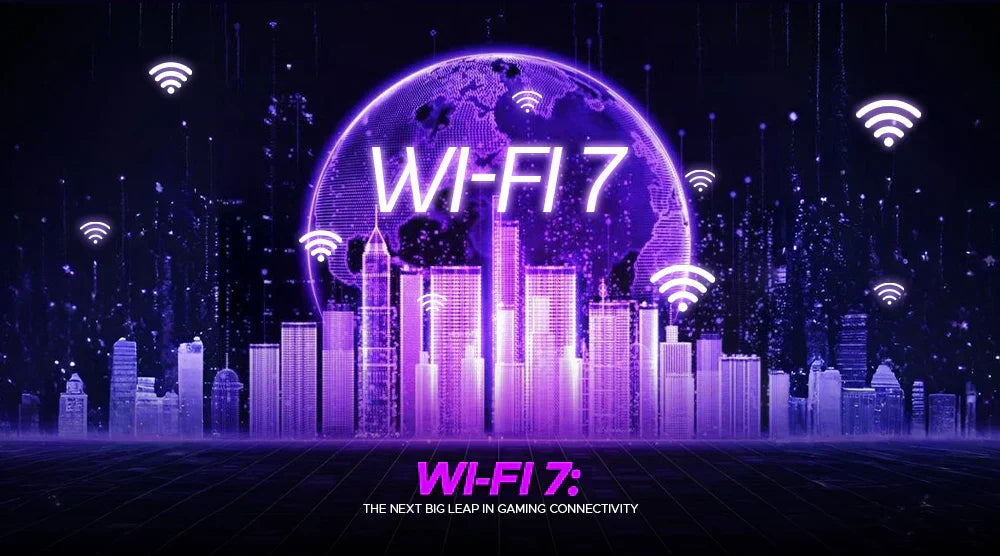The world of gaming is in a state of perpetual change, from blocky arcade games to immersive 4K multiplayer environments. Yet, as game design and graphics evolve, so must the need for blazing-fast, ultra-reliable internet connectivity. Step forward to Wi-Fi 7, the latest generation of wireless connectivity technology, which promises to revolutionize the way we play games online.
In this blog, we’ll explore how Wi-Fi has evolved, what Wi-Fi 7 (also known as IEEE 802.11be) brings to the table, and why it’s poised to become the next-gen wireless technology that every serious gamer needs.
What Is Wi-Fi 7?
Wi-Fi 7, also known as IEEE 802.11be, is the newest wireless technology that offers an extension of the functionality of Wi-Fi 6 and Wi-Fi 6E. It is made to support next-generation bandwidth-intensive applications such as 8K video streaming, cloud gaming, and VR. It is touted to offer performance improvements that will render previous standards obsolete.
Wi-Fi 7 Key Features
-
Lightning Speed: Up to 46 Gbps, more than 4x quicker than Wi-Fi 6.
-
Broader Channels: Employing 320 MHz channels (twice the size of Wi-Fi 6).
-
Multi-Link Operation (MLO): Concurrent use of two or more bands (2.4GHz, 5GHz, 6GHz) for increased performance and reliability.
-
Lower Latency: Almost zero lag for real-time gaming and video streaming.
-
Enhanced MU-MIMO: Improved bandwidth sharing among multiple devices.
These features not only improve speed but also stability, responsiveness, and interference, all of which are important for Wi-Fi 7 gaming.
Why Wi-Fi 7 Is a Game-Changer for Gamers
If you're a professional gamer or an everyday streamer, here's how Wi-Fi 7 revolutionizes your experience:
Lower Latency
Milliseconds count with gaming. Wi-Fi 7 reduces response times significantly, providing gamers with faster reflexes and tighter controls, particularly for first-person shooters or battle royale games.
Smooth Multiplayer Sessions
Wi-Fi 7 can handle dozens of high-bandwidth connections at a time. That translates to no more spikes in lag during clan games or online raids.
Cloud Gaming and Streaming
As streaming platforms such as NVIDIA GeForce Now and Xbox Cloud Gaming become increasingly popular, speed and reliability in connectivity are not optional. The speed and dependability of Wi-Fi 7 provide seamless cloud gaming — no lost frames or buffering.
No Congestion Anymore
Residing in a dense city or a shared family home?
Multi-Link Operation automatically distributes your traffic across multiple bands, minimizing interference and maintaining low ping.
Wi-Fi 7 vs. Wi-Fi 6/6E: What's the Difference?
Here's a side-by-side comparison of the most important specs:
-
Comparing Wi-Fi 7 to its predecessors, the upgrades are significant. While both Wi-Fi 6 and Wi-Fi 6E top out at 9.6 Gbps speeds, Wi-Fi 7 has a dramatic improvement with up to 46 Gbps, over four times as fast. It also doubles the channel bandwidth, from 160 MHz in the past to 320 MHz, enabling much more data to pass through at the same time.
-
In contrast to Wi-Fi 6 and 6E, which both work within separate frequency bands (2.4GHz and 5GHz, with 6E introducing 6GHz), Wi-Fi 7 is able to link all three together at the same time using Multi-Link Operation (MLO), enhancing speed and reliability.
-
Latency is also significantly lower, from an average of about 15–20ms on Wi-Fi 6/6E to only 2ms or lower on Wi-Fi 7, a huge plus for gamers. Finally, although Wi-Fi 6 and 6E do not support MLO, Wi-Fi 7 embraces this feature to the fullest, hence being the most future-proof and performance-oriented standard yet.
Real-World Gaming Use Cases:
-
Streaming 4K gameplay while on a Zoom call, silky smooth on Wi-Fi 7.
-
Competitive esports tournaments enjoy lag-free, seamless performance.
-
VR multiplayer games, no interruptions to 360° action.
Hardware That Supports Wi-Fi 7 and How to Install It
Hardware That Supports Wi-Fi 7:
-
New-generation routers (TP-Link Archer BE900, Netgear Nighthawk RS700).
-
Smartphones and laptops with Wi-Fi 7 chipsets (Qualcomm FastConnect 7800, MediaTek Filogic 880).
-
Wi-Fi 7 PCIe cards or USB adapters for desktops.
Do You Need a Wi-Fi 7 Motherboard?
Not necessarily. Most motherboards don't include built-in Wi-Fi 7 (yet). However, you can:
-
Insert a Wi-Fi 7 PCIe card.
-
Employ a USB Wi-Fi 7 adapter.
-
Switch to a gaming laptop with native Wi-Fi 7.
Final Thoughts
Wi-Fi 7 is more than just an upgrade—it's a leap into the future of seamless connectivity for gamers. Whether you're diving into fast-paced esports, streaming ultra-HD content, or exploring immersive VR worlds, Wi-Fi 7 ensures that your experience is smooth, responsive, and lag-free.
With its blazing speeds, ultra-low latency, and intelligent bandwidth management, it’s clear that Wi-Fi 7 is built for the demands of next-gen gaming.
Ready to upgrade your gaming setup?
Explore Technoid Inc.’s range of Wi-Fi 7–ready prebuilt gaming PCs, designed for unmatched speed, rock-solid stability, and next-level performance.
Unlock your ultimate gaming experience today!
FAQs
1. Is Wi-Fi 7 worth it for a gamer?
Absolutely! Wi-Fi 7 provides ultra-low latency, increased speed, and enhanced stability, all essential for contemporary online and cloud-based gaming.
2. Can I upgrade my existing PC to be Wi-Fi 7 capable?
Yes. You can simply install a compatible Wi-Fi 7 PCIe network card or a USB adapter if your motherboard does not support it natively.
3. Will Wi-Fi 7 increase my ping in games?
It can greatly lower ping, particularly in heavy areas where interference would normally lead to lag.
4. Do I need a special internet plan to employ Wi-Fi 7?
Though Wi-Fi 7 supports speeds of up to 46 Gbps, your speed will vary based on your ISP subscription. Your speed will, nonetheless, be complemented by improved reliability and lower latency.

 United States
United States

